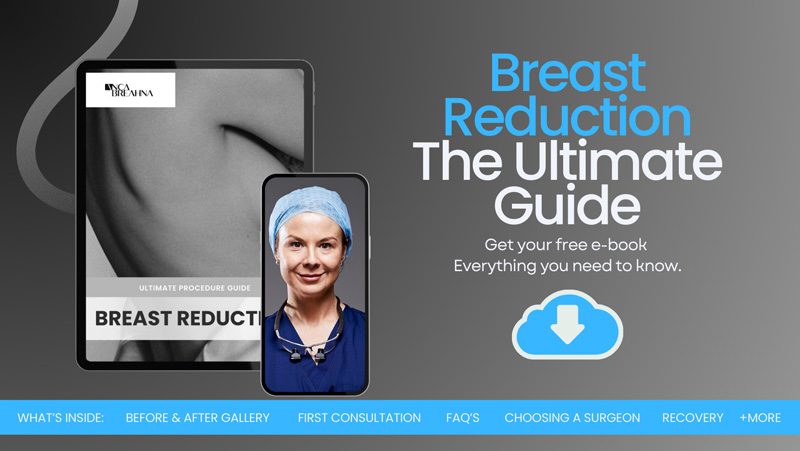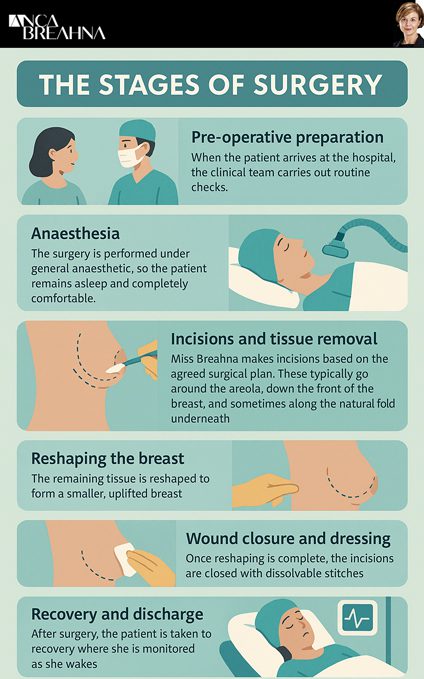
Important Considerations before Getting a Breast Reduction Surgery
Breast reduction is a surgical procedure to reduce the size and weight of large breasts. For many, it’s a step towards alleviating physical discomfort such as back pain, neck pain, and skin irritation. This procedure involves the removal of excess breast tissue, fat, and skin to achieve a breast size in proportion with your body. Breast reduction can help in reducing the physical and emotional burden of overly large breasts. This procedure might also include reshaping the breasts to enhance their overall appearance.
Consultant Plastic Surgeon Anca Breahna, based in Chester, UK, is renowned for her expertise in the field. She stands out as one of the most in-demand female Plastic Surgeons in the UK, specialising in breast surgery including procedures like breast reduction. In this blog, Anca aims to guide you through the vital aspects to consider before undergoing a breast reduction.
Download Anca’s Breast Reduction Surgery Guide

1. Medical Evaluation before Breast Reduction 
Before going ahead with breast reduction, a full check-up of your health is a must. This isn’t just a quick look-over; it’s a detailed review. Here’s what it involves:
- Checking Your Current Health: Anca will look at how you are right now. This includes your weight, blood pressure, and any immediate health issues. She needs to make sure you’re healthy enough for surgery
- Reviewing Underlying Medical Conditions: If you have any long-term health problems like diabetes or heart issues, these need to be talked about. Some conditions can affect how you heal or the increase the risks of surgery
- Looking at Your Family Medical History: Your family’s health history can give clues about risks you might face. For example, if blood clots are common in your family, this could be important for surgery
- Medications and Allergies: Tell Anca about any medicines you take and if you have allergies. Some medicines can affect surgery and healing
- Lifestyle Factors: Things like smoking or drinking can affect your surgery and recovery. Be honest about these, as they’re key for planning safe surgery
If you’ve had surgery before, especially on your breasts, it’s vital to tell your plastic surgeon. Here’s why:
- Impact on Surgery Planning: Past surgeries might change how Anca plans your breast reduction. She needs to know what’s been done before to plan the best approach
- Scarring and Healing: Previous surgeries might have left scars or changed how you heal. Your surgeon needs to know this to predict how you’ll heal this time
- Changes in Breast Tissue: If you’ve had surgery on your breasts, it might have changed the tissue there. This can affect everything from how the surgery is done to how you’ll look afterwards
- Risk of Complications: Past surgeries might raise the risk of problems with your breast reduction. Anca needs the full picture to keep you safe
2. Understanding the Risks and Complications
When you’re considering breast reduction surgery, it’s important to be aware of the common risks that come with it. Remember, all surgeries have their risks, and being informed helps you make a better decision.
- Reactions to Anaesthesia: Anaesthesia is used to keep you asleep and pain-free during surgery. But some people might react to it. This can range from feeling sick when you wake up to more serious issues
- Bleeding During or After Surgery: There’s always a chance of bleeding during any surgery. Your surgeon will take steps to manage this risk. If you bleed more than expected after surgery, you might need extra care or even another operation
- Risk of Infection: Any cut on your body can get infected, and this includes surgical cuts. Infections can be minor or serious. You’ll get instructions on how to keep your surgery area clean to help stop infections
- Scarring: Scars are a normal part of surgery. How big and noticeable they are depends on how you heal and the surgery technique. Anca will try to make scars as small as possible, and they’ll usually fade over time
- Changes in Sensation: After surgery, you might feel different in your breasts or nipples. This could be more or less feeling than before. For many, this change is temporary, but for some, it can last longer or be permanent
Potential Long-Term Complications
While most women recover well from breast reduction surgery, some might have long-term complications. It’s rare, but it’s good to know about them:
- Difficulties in Breastfeeding: If you plan to have kids and breastfeed, this surgery might make it harder. It can affect how much milk you make and how easy it is to feed. Talk to Anca about this if it’s important to you
- Unevenly Positioned Nipples: Sometimes, after surgery, your nipples might not line up like they used to. This can happen if there’s a lot of change in your breast size or shape. Anca will try to prevent this, but it’s not always possible
- Permanent Loss of Sensation: Losing feeling in your nipples or breasts can happen. This means you might not feel touch the same way there. For some, this is a big change, and it’s worth thinking about before you decide on surgery
3. Financial Considerations

Breast reduction surgery isn’t just a big decision for your health; it’s also a big financial decision. The cost isn’t the same for everyone; it changes based on several things. Here’s what you need to think about:
- Surgeon’s Fee: This is what you pay the surgeon for doing the operation. It can vary a lot depending on their experience and where they work
- Facility Costs: The place where you have your surgery, like a hospital or clinic, will charge for using their space and equipment
- Anaesthesia Fees: This is what you pay for the drugs that keep you asleep and pain-free during surgery. The cost can change based on how long your surgery takes
- Geographical Location: Where you live can affect the cost. Surgery might be more expensive in big cities than in smaller towns
- Additional Expenses: Don’t forget about other costs like follow-up care, any special bras you need after surgery, and travel costs if you’re going to a surgeon far from home
Get a detailed breakdown of all these costs from Anca’s office. This helps you plan and avoid surprises.
4. Preparing for Surgery
Getting ready for breast reduction surgery isn’t just about the day itself. There’s a lot you need to do beforehand to make sure everything goes smoothly. Here’s what’s usually involved:
Pre-Surgical Requirements
Anca will give you a list of things to do before the surgery. It’s really important to follow these instructions.
- Medical Tests: You might need some tests to check your health. This could include blood tests or a heart check. If you’re over a certain age or have a family history of breast problems, a mammogram might be needed
- Medication Review: Tell your plastic surgeon about all the medicines you take. This includes prescription drugs, over-the-counter meds, and herbal supplements. You might need to stop taking some of them before surgery, especially ones that can increase bleeding
- Fasting before Surgery: You’ll likely be asked not to eat or drink anything for a certain time before your surgery. This is standard for most surgeries to keep you safe while you’re under anaesthesia
Lifestyle Adjustments
In the weeks leading up to your surgery, you might need to make some changes to your lifestyle.
- Quit Smoking: Smoking can really affect how you heal. If you smoke, you’ll be asked to stop for a while before and after your surgery. This helps your body heal better and reduces the risk of complications
- Healthy Diet: Eating well before surgery can help your body get ready for the healing process. Focus on eating plenty of fruits, vegetables, and lean proteins. Learn more about the benefits of an anti-inflammatory diet before plastic surgery to support optimal recovery
- Getting Your Home Ready: Think about what you’ll need during recovery. This includes things like comfortable clothes that are easy to put on and take off, a support bra to wear after surgery, and a place to rest where you can be comfortable
- Arranging Help: You’ll need someone to take you home after surgery and stay with you for at least the first night. It’s also good to have help around for a few days as you’ll be sore and tired
5. Recovery and Aftercare
After surgery, you will need time to rest and recover. Follow Anca’s instructions on wound care, managing pain, and when to resume normal activities. You’ll need to wear a special support bra and avoid physically demanding activities for a certain period.
Long-Term Care and Maintenance
Long-term care is essential for maintaining the results of your surgery. This includes attending follow-up appointments, adhering to a healthy lifestyle, and monitoring any changes in your breasts. Regular self-examinations and mammograms as recommended by your healthcare provider are also important.
6. Impact on Lifestyle and Activities

In the weeks following surgery, you’ll need to make adjustments to your daily routine. This includes taking time off work, avoiding lifting heavy objects, and modifying your exercise regimen. It’s important to give your body the time it needs to heal properly.
Long-Term Lifestyle Changes
Breast reduction can lead to positive lifestyle changes. You may find it easier to engage in physical activities and feel more comfortable in your clothing. It’s also an opportunity to embrace a healthier lifestyle, as maintaining your weight can help preserve the results of your surgery.
7. The Final Results Take Time
After your surgery, patience is key. The final results of your breast reduction won’t be immediately visible. Initially, there will be swelling and bruising, which can take several weeks to months to fully subside. Your breasts will also continue to change shape and settle over time. Scars from the surgery will gradually fade, although they won’t disappear completely. It’s important to follow Anca’s advice on scar care to ensure the best possible healing. Remember, it can take up to a year to see the final outcome of your surgery.
8. It May Have an Effect on Breastfeeding
If you’re planning to have children in the future, it’s important to consider the impact of breast reduction surgery on breastfeeding. The surgery can involve removing breast tissue and repositioning the nipple, which can affect milk production and delivery. While some women might still be able to breastfeed after surgery, some may experience reduced milk supply. Discuss your future plans with Anca, as she can tailor the surgical technique to preserve as much of the milk-producing ability as possible.
9. A Breast Lift Is Part of the Process
When you’re considering breast reduction surgery, it’s important to understand that a breast lift is usually part of this procedure. While breast reduction focuses on reducing the size of your breasts by removing excess fat, tissue, and skin, a breast lift involves reshaping and lifting the remaining breast tissue. This combination is necessary because after the reduction, the skin and tissue might sag due to the decreased volume. The lift helps to give your breasts a more natural and aesthetically pleasing shape. Your plastic surgeon will explain how both procedures work together to achieve the desired outcome. It’s a common practice, and understanding this will help you set realistic expectations for your surgery.
10. Setting Realistic Expectations
It’s important to have realistic expectations about the physical outcomes of breast reduction. While the surgery can significantly improve your appearance and relieve physical discomfort, it may not result in ‘perfect’ breasts. Factors like age, skin elasticity, and body shape play a role in the final outcome.
FAQs about Breast Reduction

What is the typical recovery time for a breast reduction surgery?
- Recovery time can vary, but most people can return to work and light activities within 2-3 weeks post-surgery. Full recovery, including the ability to resume strenuous activities and exercise, typically takes 6-8 weeks. However, individual recovery times can vary based on overall health, age, and the extent of the surgery.
Will breast reduction surgery leave noticeable scars?
- Scarring is inevitable with any surgery, including breast reduction. However, the extent of scarring can vary. Anca uses techniques to minimise scarring, and with proper care, scars typically fade over time. The scars are usually around the areola, vertically down from the areola to the breast crease, and sometimes along the crease under the breast.
How long do the results of a breast reduction last?
- The results of a breast reduction are generally long-lasting. However, factors like significant weight fluctuations, hormonal changes, and ageing can affect breast size and shape over time. Maintaining a stable weight and healthy lifestyle can help sustain the results.
Further Reading about Breast Reduction with Consultant Plastic Surgeon Anca Breahna
- Read more about 8 Myths about Breast Reduction Surgery
- Read more about How Soon Can I Exercise after Breast Reduction Surgery
- Read more about Reduce Swelling and Bruising after Breast Reduction Surgery
- Read Anca’s Blog Breast Reduction for Adolescents and Young Women
- Read more about How to Reduce Scars after Breast Reduction Surgery
- Read more about 9 Things You Need to Do After Breast Reduction Surgery
- Read more about Who Is the World’s Best Breast Reduction Surgeon?
- Read more about What Is Normal during Breast Reduction Recovery
- Read more about Breast Reduction Surgery and Age: Considerations for Different Life Stages
- Read more about Solutions for Heavy Breasts
- Read more about Causes and Solutions for Huge Breasts (Gigantomastia)
Medical References about Breast Reduction
- Breast Reduction Surgery Guide | ABCS
- Breast Reduction | American Society of Plastic Surgeons
- Breast Reduction Surgery | Johns Hopkins Medicine
- Breast Reduction surgery – Mayo Clinic
- Breast Reduction – Cleveland Clinic
 Ms Anca Breahna, PhD, MSc, FEBOPRAS, FRCS (Plast) is a highly regarded Consultant Plastic Surgeon specialising in the field of Aesthetic and Reconstructive Plastic Surgery. Anca performs a range of
Ms Anca Breahna, PhD, MSc, FEBOPRAS, FRCS (Plast) is a highly regarded Consultant Plastic Surgeon specialising in the field of Aesthetic and Reconstructive Plastic Surgery. Anca performs a range of 